Sourdough Starter Vs Yeast: How Each Impacts Your Baking
When you compare sourdough starter and commercial yeast, you’ll find significant differences that affect your baking. Sourdough starter is a natural mixture of flour and water that captures wild yeast and bacteria, resulting in a longer fermentation process that yields complex flavors.
In contrast, commercial yeast, like Saccharomyces cerevisiae, rises quickly, allowing for same-day baking. While sourdough offers rich flavors and improved digestibility, its preparation requires more time and regular feeding.
On the other hand, commercial yeast provides convenience but lacks the depth of taste found in sourdough. Discovering these nuances can enhance your baking experience and flavors.
Key Takeaways
- Sourdough starter relies on wild yeast and bacteria, requiring longer fermentation (12 hours to several days) for flavor development compared to commercial yeast’s quick rise (30 minutes to 2 hours).
- The flavor profile of sourdough is complex and tangy, while commercial yeast produces a milder, straightforward taste due to rapid fermentation.
- Sourdough fermentation improves digestibility by breaking down gluten and phytic acid, offering potential health benefits over commercial yeast.
- Regular feeding and maintenance are essential for sourdough starter viability, unlike the convenience of using commercial yeast for immediate baking.
- Sourdough bread has a lower glycemic index, making it a healthier option for blood sugar management compared to bread made with commercial yeast.
Yeast and Sourdough Starter Overview
When comparing yeast and sourdough starter, it’s vital to understand their fundamental differences and unique characteristics. Yeast, specifically Saccharomyces cerevisiae, is a cultivated strain widely used as a leavening agent in baking. It comes in various forms, including instant yeast, which requires no blooming, active dry yeast that needs activation in water, and fresh yeast, preferred by professional bakers for its potency and freshness.
In contrast, sourdough starter is a natural mixture of flour and water that captures wild yeast and lactic acid bacteria over time, resulting in a unique fermentation process. This method of fermentation is essential for making sourdough bread in a bread machine, as it contributes to the complex flavors and textures that define sourdough.
On the other hand, sourdough starter has a batter-like consistency and develops mousse-like bubbles due to the fermentation processes that occur as wild yeast and bacteria proliferate. The fermentation with sourdough is considerably slower than with commercial yeast, often taking hours to days. This slower process leads to a more complex flavor profile as organic acids develop, contributing to the distinctive taste of sourdough.
However, the unpredictability of sourdough starter can result in varying baking outcomes, in contrast to the consistent and reliable results provided by commercial yeast for quicker baking applications.
Key Differences Between Yeast and Sourdough
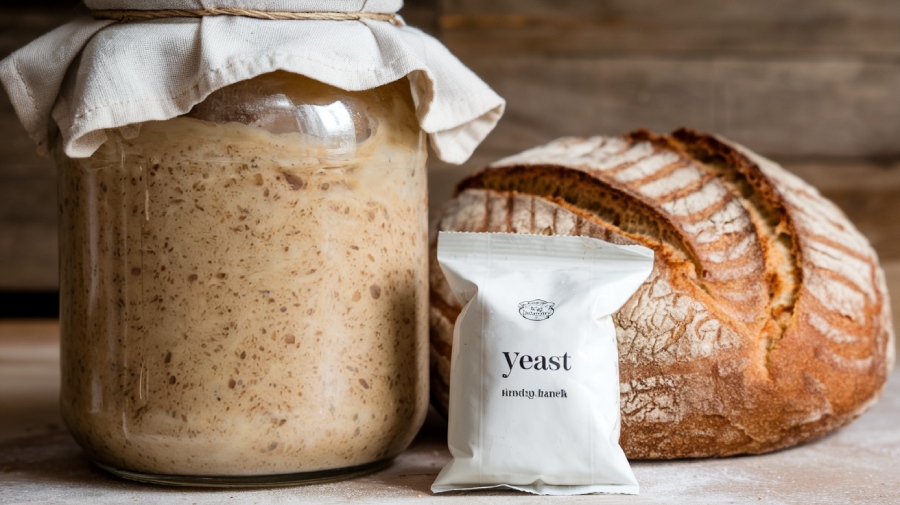
When comparing sourdough and commercial yeast, you’ll notice significant differences in fermentation time and flavor profiles.
Sourdough takes much longer to ferment, often resulting in a rich, complex flavor, as it benefits from a sourdough starter creation and maintenance process that enhances taste.
In contrast, commercial yeast offers a quick rise with a more straightforward taste.
Understanding these differences can help you choose the right option for your baking needs.
Fermentation Time Comparison
In comparing fermentation times, it becomes clear that sourdough starter and commercial yeast operate on distinctly different timelines. While commercial yeast can produce a rise in as little as 30 minutes to 2 hours, sourdough starter fermentation can take anywhere from 12 hours to several days. This extended fermentation time is largely due to the reliance on wild yeast and lactic acid bacteria, which creates a more variable and unpredictable rising process.
The longer fermentation associated with sourdough contributes to the development of complex flavors and improved digestibility, as it breaks down gluten and phytic acid. You might also use cold fermentation methods with sourdough, extending rise times even further and enhancing flavor complexity—often requiring an overnight rise in the refrigerator.
These differences in fermentation time considerably impact the texture and taste of the final bread product. While sourdough generally results in a chewier crust and a more nuanced flavor, commercial yeast provides quick, straightforward results.
Flavor Profile Differences
The flavor profile of sourdough bread stands in stark contrast to that of bread made with commercial yeast, showcasing the intricate effects of their fermentation processes. Sourdough, created through a sourdough starter, benefits from both wild yeast and lactic acid bacteria. This combination results in a complex, tangy flavor that evolves over extended fermentation periods, sometimes lasting several days.
The use of whole grain flours in sourdough can further enhance this flavor complexity, as they promote the growth of acetic acid-producing bacteria.
In contrast, bread made with commercial yeast generally presents a milder, more straightforward flavor. This blandness arises because the rapid fermentation—often completed in as little as 30 minutes—limits the development of deeper, nuanced flavors.
The unique taste of sourdough is further enhanced by the production of lactic and acetic acids during fermentation, contributing to its distinctive aroma and tang.
Moreover, the lower glycemic index of sourdough bread not only influences its flavor but also makes it more satisfying, providing a longer-lasting taste experience compared to commercial yeast bread.
Advantages and Disadvantages
Understanding the advantages and disadvantages of sourdough starter and commercial yeast is essential for anyone diving into bread-making. Many bakers find that sourdough starter is better for their health due to its natural probiotics, which promote gut health and lower glycemic index, aiding in blood sugar management.
Additionally, sourdough reduces phytic acid, enhancing nutrient absorption. The fermentation process involved in sourdough also increases fiber content, which can also help in stabilizing blood sugar levels, making it a favorable choice for those managing diabetes. Furthermore, homemade sourdough bread typically has a lower glycemic index compared to regular bread, thereby offering a healthier baking option for many individuals lower glycemic index.
However, maintaining a sourdough starter requires regular feeding and can be time-consuming, with longer fermentation times compared to commercial options.
On the other hand, Active Dry Yeast offers convenience and consistency, allowing for same-day baking with minimal rise time.
Yet, while commercial yeast simplifies the process, it often results in a straightforward flavor and lacks the complex taste and health benefits found in sourdough. In addition, the rapid fermentation of commercial yeast can lead to blood sugar spikes, which some may want to avoid.
Ultimately, choosing between sourdough starter and Active Dry Yeast involves weighing the health benefits and flavor complexity of sourdough against the convenience and speed of commercial yeast.
Baking Techniques With Yeast and Sourdough
While both yeast and sourdough starter can produce delicious bread, the techniques employed in each method reveal distinct approaches to baking. When you use bakers yeast, you typically experience a quick rise, with dough often ready in just 30 minutes.
In contrast, sourdough baking techniques involve longer fermentation times, usually 12-24 hours, which enhances the flavor complexity of your rise bread.
Using a sourdough starter requires you to adjust flour and water ratios in your recipes, maintaining a 1:1 ratio by weight to accommodate the starter’s hydration level.
During bulk fermentation, stretching and folding are essential for promoting gluten development, resulting in an open crumb structure that’s less prominent in yeast-based breads.
If you’re short on time, combining sourdough starter with commercial yeast offers a hybrid approach. This lets you enjoy the unique flavors of sourdough while ensuring a reliable rise for quicker outcomes.
Additionally, yeast recipes demand precise measurements and timings, whereas sourdough techniques rely more on visual and tactile cues, such as the starter doubling in size and bubbling, to determine readiness.
Understanding these techniques can elevate your bread-baking skills considerably.
Health Benefits of Sourdough Bread
Have you ever wondered why sourdough bread is often hailed as a healthier option compared to conventional bread? The secret lies in the unique properties of the sourdough starter and the fermentation process. Here are three key health benefits you can expect:
- Lower Glycemic Index: Sourdough bread typically has a lower glycemic index, which means it’s less likely to cause rapid spikes in blood sugar levels—great news for diabetics.
- Improved Digestion: The fermentation process effectively breaks down gluten and phytic acid, promoting healthier digestion and better nutrient absorption. This makes sourdough a more digestible choice for many.
- Gut Health Support: Sourdough contains natural live yeasts that support beneficial gut bacteria, contributing to overall gut health.
Additionally, the presence of lactic acid can help reduce digestive issues, making sourdough a preferable option for those with gluten sensitivities.
Regularly consuming sourdough bread can also lead to prolonged satiety, helping you feel fuller for longer.
Comparing Yeast Types for Baking
When it comes to baking, understanding the different types of yeast can greatly impact your results. The three main types are instant yeast, active dry yeast, and fresh yeast, each with unique characteristics.
Instant yeast, with its fine granules, can be mixed directly into dry ingredients, allowing for a rapid rise in your dough. This makes it ideal for quick baking projects.
On the other hand, active dry yeast is grainier and requires blooming in warm water or milk before you use it. This activation process can be beneficial for recipes that necessitate longer fermentation times, giving your bread a richer flavor profile.
Fresh yeast, or cake yeast, is favored by some professional bakers for its robust taste. However, it must be refrigerated and you’ll need to double the amount used compared to dry yeast.
While commercial yeasts can lead to dough rising in as little as 30 minutes, sourdough starters demand longer fermentation periods, which enhance flavor complexity and provide additional nutritional benefits.
Frequently Asked Questions
Is Sourdough Starter Better Than Yeast?
Did you know sourdough bread has a 54% lower glycemic index than traditional bread?
If you’re considering which option’s better for baking, sourdough starter offers a more complex flavor and improved digestibility due to its natural fermentation. It promotes gut health through live bacteria, unlike commercial yeast.
However, it requires more time and care for maintenance. If you value flavor and health benefits, sourdough might be the way to go.
Can I Substitute Sourdough Starter for Yeast?
Yes, you can substitute sourdough starter for yeast in your recipes.
To do this, measure about 1 cup of starter for each packet of yeast, adjusting the flour and water accordingly.
Keep in mind that fermentation and proofing will take longer, often several hours or overnight.
You’ll also notice a more complex flavor in your bread due to the natural fermentation process, enhancing both taste and nutritional value.
Is Sourdough Better for You Than Yeast?
When considering which bread option is better for you, sourdough often stands out. Its lower glycemic index helps prevent blood sugar spikes, while the fermentation process enhances nutrient absorption and digestion.
You might find it easier on your gut, as sourdough’s natural bacteria can promote gut health. Additionally, sourdough tends to keep you fuller longer, making it a more satisfying choice overall compared to traditional yeast bread.
Why Is Sourdough Starter Better?
Imagine biting into a slice of bread that dances on your palate, a symphony of flavors crafted by nature.
Sourdough starter’s unique blend of wild yeasts and bacteria creates a complex taste and enhances nutrition. Its fermentation process breaks down gluten, making it gentler on your digestive system.
Plus, the lower glycemic index helps maintain stable blood sugar levels. Regularly indulging in sourdough can also nurture your gut health, making it a superior choice.
Choosing Your Rise: The Unique Benefits of Sourdough and Yeast
In the grand bakery of life, choosing between yeast and sourdough starter is like selecting the perfect instrument for a symphony. Each brings its own melody and character to your bread, shaping flavors and textures uniquely.
While yeast delivers speed, sourdough offers depth, nurturing your health with every bite. Whether you embrace the quick rise of yeast or the slow dance of sourdough, each choice enriches your culinary repertoire, inviting you to explore the art of baking with passion and precision.


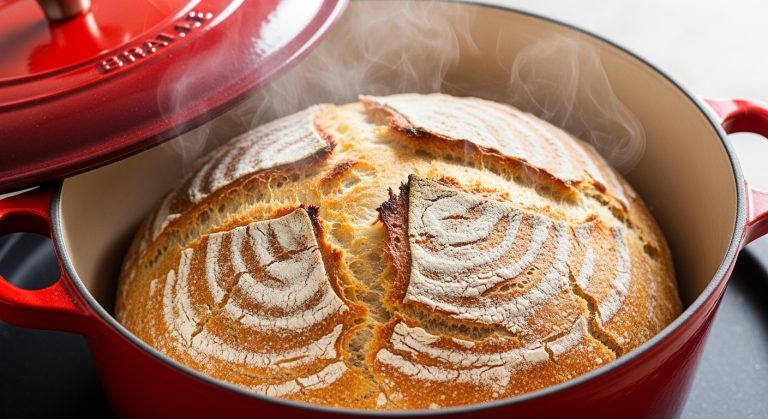

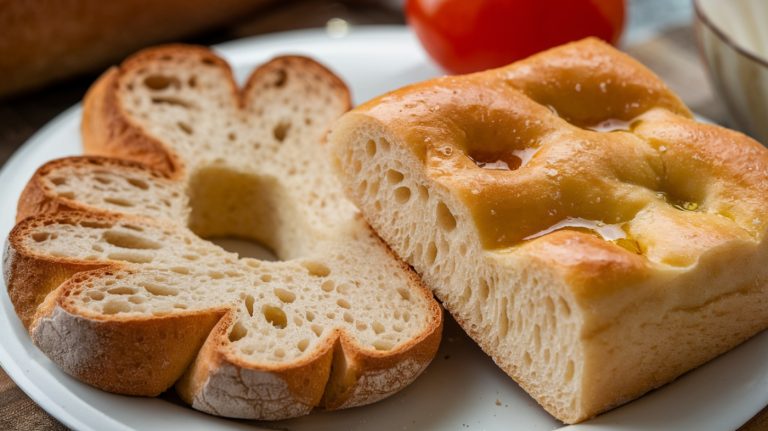
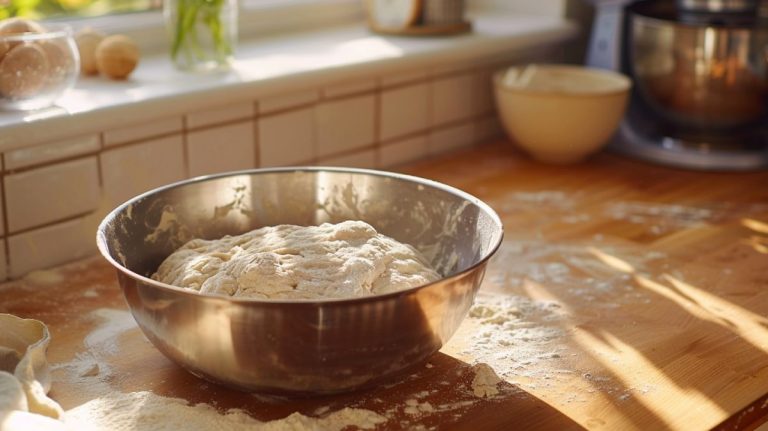
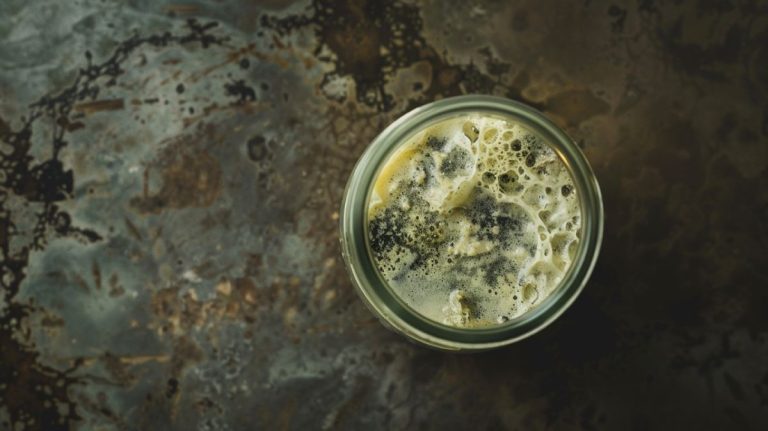
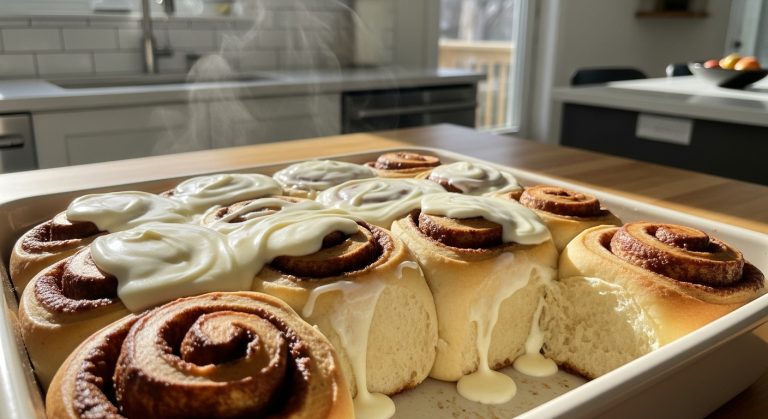
Making the sourdough starter takes several days. Using am active starter to make sourdough bread takes several hours, or some hours and leaving the dough in the fridge overnight, but not several days.